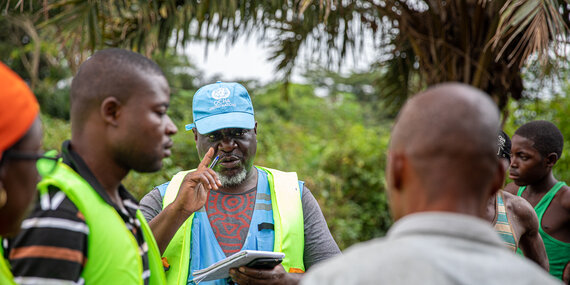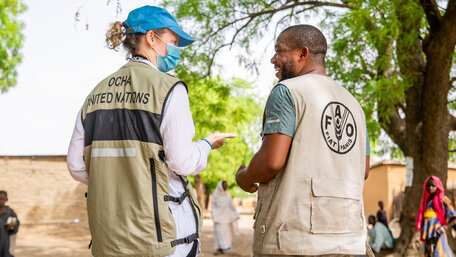Libenge, DRC
A humanitarian worker talks with Libenge residents after floods hit the region. Heavy rains caused the Oubangui River to overflow, affecting 73 villages on its banks. The waters began to recede after a few weeks, leaving behind fragile earth and clay-brick homes, which often need partially or completely rebuilding. OCHA/Alioune Ndiaye
Humanitarian systems can respond more appropriately if they understand and acknowledge the multiple and different ways in which people and communities experience shocks. Understanding the needs of different groups of people also helps support decisions on the timing and sequencing of humanitarian assistance as well as appropriate response modalities, and gets aid to where it is needed most. This approach is referred to as intersectoral analysis.
Everyone experiences crisis differently
Devastated by 40 years of war, recurrent natural disasters, chronic poverty, drought and COVID-19, Afghanistan was already suffering one of the world’s worst humanitarian crises before the sharp increase in hostilities during mid-2021. As the Taliban made rapid territorial gains, widespread displacement, the destruction of homes, health facilities and schools, and a roll back of fundamental rights resulted in restricted access to services, particularly for women and girls. By 15 August, when the Taliban took control of the capital, Kabul, nearly half of the population needed humanitarian and protection assistance.
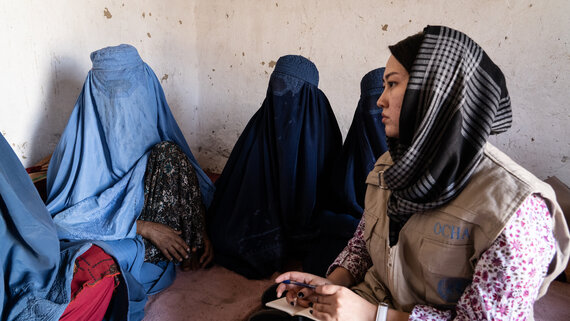
Surkh Rod , Afghanistan
A humanitarian worker talks with a woman displaced to the Surkh Rod area in Nangahar Province. The community will receive core relief items to help them during the winter. Implementing partner IMC is delivering the aid, supported by the Afghanistan Humanitarian Fund.
OCHA/Charlotte CansAs humanitarian conditions deteriorated, no one in Afghanistan experienced the crisis in the same way. Differences in age, gender, disability, socioeconomic situations, living conditions, physical and mental well-being, and coping mechanisms determined each person’s specific needs and coping abilities. At the same time, when different needs overlapped, their impacts were often magnified: without safe shelter, physical and mental health conditions were exacerbated; without safe access to schools, education stalled; without water, food provision and hygiene were compromised.
This example illustrates how humanitarians identify needs: start with an overview of the context, then analyse the shock or stressors and their immediate impacts and consequences on the population’s humanitarian conditions. Then, as granularly as possible, disaggregated by age, gender and diversity characteristics.
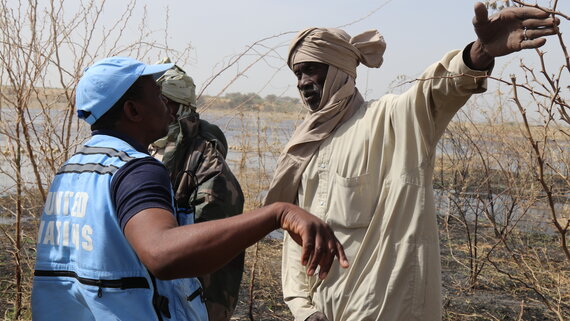
Yakou, Chad
A humanitarian worker and Yakou’s Sous-Préfet discuss the best way to reach IDPs in Fouli Department, Lac Province.
OCHA/Augustin ZusanneJIAF evolves
The first iteration of the Joint Intersectoral Analysis Framework (JIAF) was introduced for the 2020 HPC. One year on, humanitarian actors are coming together with a common aspiration: to improve the effectiveness of humanitarian action. From CAR to Colombia, Yemen to Ukraine, South Sudan to Syria, and in dozens of crises around the globe, a robust, more people-centred joined-up analysis of people’s needs is taking place.
In 2021, 25 country teams continued to advance joint analysis, delivering on the promise of enhanced quality HNOs and more strategic HRPs through evidence-based needs assessments. Based on country office feedback, revised and strengthened JIAF guidance was released to help humanitarian communities work towards a more holistic and intersectoral analysis.
Country teams have found new ways to provide a contextually rich overview of people most vulnerable, where they live and the complex multiplicity of needs they face. Local communities are now more actively engaged, bringing their unique perspectives into HNOs. In some countries, peace and development actors are also coming to the table to discuss the immediate, underlying and root causes of crises with humanitarians.
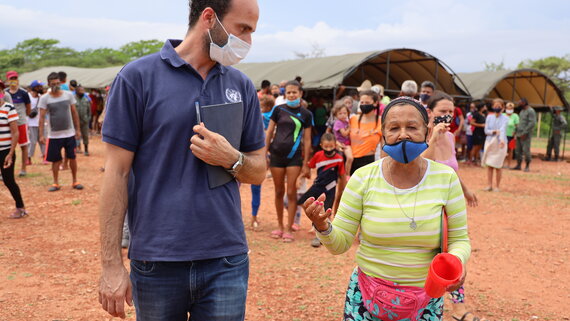
Paraguachón, Venezuela
A humanitarian worker talks with a Venezuelan returnee at the border's temporary shelter for people who recently returned from Colombia.
OCHA/Naomi FrerottePromising practices and emerging trends from the field
In CAR, the JIAF was guided by a comprehensive community consultation and participation strategy in 2021. Affected populations participated in the analysis dialogue through household and individual interviews, focus groups and open community dialogues. Children were directly consulted on their situation, their perspectives and the protection risks they face. During community dialogues, community members’ recommendations were presented. A similar process took place in Burundi, where local actors participated throughout the JIAF process.
In Afghanistan, the country team used the JIAF as the basis for understanding the depth of needs and vulnerabilities and plan for a more comprehensive set of assistance packages – in terms of volume, duration and quality. The Afghanistan example illustrates how joining forces and bringing different perspectives can enrich the overview of people’s needs and help plan a comprehensive response.
Iraq HRP: Adopting the JIAF methodology

For 2022, amidt a changing context, increasing focus on durable solutions and decreasing humanitarian capacities and funding, the humanitarian community in Iraq significantly revised its processes to determine humanitarian needs and ensure strict prioritization for programmatic interventions. These processes were revised to be more strictly data driven using a common methodology; guided by strategic priorities; transparent; and inclusive of all key stakeholders.
Based on the globally agreed JIAF methodology, the HCT, Inter-Cluster Coordination Group and donors jointly considered the context and its impacts, analysed the consequences for humanitarian needs, and agreed on a set of needs indicators that would inform the intersectoral PiN and severity. The results of the intersectoral and cluster-specific analytical frameworks were reviewed by a panel led by the HC and consisting of HCT representatives from UN agencies, international and national NGOs, and donors. Preliminary findings were adjusted to ensure a focus on people with multiple needs for emergency humanitarian response, and the intersectoral PiN was raised to include needs found by clusters that fit those criteria but had not been captured by the initial intersectoral model. This resulted in a final proposal for PiN and severity, which was then further reviewed in a full session with all HCT members, cluster coordinators and donor representatives, after which a final agreement was reached on the figures.
A similar approach to reviewing cluster response activities and targeting is also being used to produce a strictly prioritized response strategy, which can serve as a high-impact, yet realistically achievable plan of action for 2022. In developing their response plans and targets, clusters were asked to use capacity, access, achievement and needs analysis data sets as the foundation for their response plans. The HC-led panel will repeat its review and feedback process, with follow-on sessions with the entire humanitarian community, to ensure full participation, transparency and agreement on the final response priority activities, targeting and financial requirements.
OCHALooking towards the future
The humanitarian community, including UN organizations, cluster leads and participants, NGOs and donors, is committed to joint intersectoral analysis. To meet this commitment with rigor and transparency, an independent expert review of the methodology took place in 2021. Its findings and recommendations are guiding further refinement and enhancement of the methodology, its guidance and supporting tools.
The JIAF will continue to be strengthened year on year. It will require continued commitment and engagement from the whole humanitarian community to consolidate the promising gains achieved so far towards a credible, transparent analysis that truly helps us deliver better.
Further reading
Source: OCHA
Source: Global Humanitarian Overview 2021

